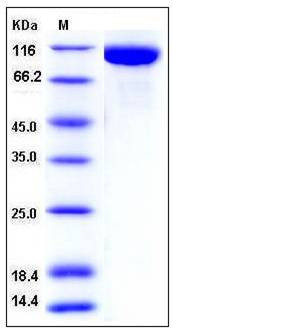Mouse TLR3 / CD283 Protein (His Tag)
AI957183,Tlr3
- 100ug (NPP3512) Please inquiry
| Catalog Number | P50161-M08H |
|---|---|
| Organism Species | Mouse |
| Host | Human Cells |
| Synonyms | AI957183,Tlr3 |
| Molecular Weight | The secreted recombinant mouse TLR3 consists of 691 amino acids and has a calculated molecular mass of 78.7 kDa. As a result of glycosylation, the recombinant protein migrates as an approximately 100-110 kDa protein in SDS-PAGE under reducing conditions. |
| predicted N | Thr 26 |
| SDS-PAGE |  |
| Purity | > 97 % as determined by SDS-PAGE |
| Protein Construction | A DNA sequence encoding the extracellular domain of mouse TLR3 (NP_569054.2) (Met 1-Leu 705) was expressed with a C-terminal polyhistidine tag. |
| Bio-activity | |
| Research Area | Immunology |Signal Transduction |Cellular Senescence and Pathways in Aging |Apoptosis |NF-kB (NFkB) Pathway |
| Formulation | Lyophilized from sterile PBS, pH 7.4 1. Normally 5 % - 8 % trehalose, mannitol and 0.01% Tween80 are added as protectants before lyophilization. Specific concentrations are included in the hardcopy of COA. |
| Background | Toll-like receptor 3 (TLR3) also known as CD283 (cluster of differentiation 283) is a member of the Toll-like receptor family of pattern recognition receptors of the innate immune system. TLR3/CD283 plays a fundamental role in pathogen recognition and activation of innate immunity. TLR3 is a nucleotide-sensing TLR which is activated by double-stranded RNA, a sign of viral infection. TLRs are highly conserved from Drosophila to humans and share structural and functional similarities. They recognize pathogen-associated molecular patterns (PAMPs) that are expressed on infectious agents, and mediate the production of cytokines necessary for the development of effective immunity. The various TLRs exhibit different patterns of expression. This receptor is most abundantly expressed in placenta and pancreas, and is restricted to the dendritic subpopulation of the leukocytes. It recognizes dsRNA associated with viral infection, and induces the activation of NF-kappaB and the production of type I interferons. It may thus play a role in host defense against viruses. |
| Reference |
